As harvest is completed in the north and continues further south, agronomists from across Australia reflect on how well their clients’ cereal crops stood up to heavy pressure from foliar diseases.
Generally, most crops were managed proactively for a range of diseases. This was based on careful variety selection and the proactive and timely use of fungicides.
However, in areas where heavy and prolonged rainfall caused waterlogging, flooding and trafficability issues, delayed fungicide applications led to disease outbreaks and significant yield losses.
Paul Castor, Queensland
 Independent agronomist Paul Castor is based in Toowoomba, Queensland. He provides advice to growers on the Darling Downs and Western Downs. He is a director of MCA Agronomy, which has offices in Chinchilla and Goondiwindi, Queensland.
Independent agronomist Paul Castor is based in Toowoomba, Queensland. He provides advice to growers on the Darling Downs and Western Downs. He is a director of MCA Agronomy, which has offices in Chinchilla and Goondiwindi, Queensland.
From late October, most cereal crops in southern Queensland had started to turn, and leaf diseases were less of a focus.
At that time, varying levels of head infection with Fusarium head blight or white grain disorder became a far greater concern than foliar diseases for growers and their advisers.
However, throughout October, we also saw the odd crop with head infections of stripe rust or powdery mildew.
Generally, we saw stripe rust in heads where stripe rust management proved inadequate due to an unexpected reaction in the case of varieties such as Sunflex or where the very wet conditions had compromised foliar fungicide application timings.
Powdery mildew head infections were noted in several susceptible (S) to very susceptible (VS) or VS varieties that were not treated with fungicides for other foliar diseases. Sunmax and Sunchaser were in this category.
With some early Sunmax crops already harvested, the late wheat powdery mildew head infections do not appear to have had significant yield or quality impacts.
Pleasingly, there were low-levels of leaf rust and yellow leaf spot infections, which were closely monitored but, in most cases, did not progress to significantly damaging levels that required specific management.
Generally, our clients managed their foliar cereal diseases very well this season.
We do not expect that any widespread losses have been sustained from leaf diseases. This result did not come without significant management input, however.
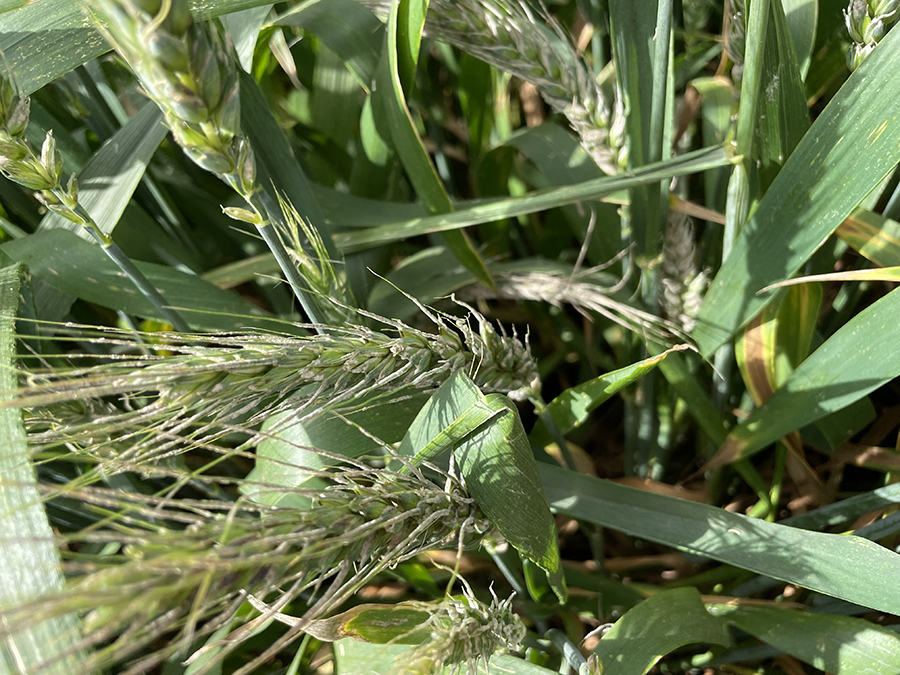
Powdery mildew in Sunmax (PBR) wheat heads west of Dalby, Queensland. Photo: MCA Agronomy
The foundation of this outcome was careful variety selection, but it also required some unusually expensive and sustained fungicide programs. For this, we must thank the product supply companies and aerial applicators for their incredible services under pressure.
Hopefully, growers’ considerable investment in time, effort and resources is well rewarded with easier conditions over the harvest period.
Double cropping
We are fielding interest from some growers for double cropping opportunities following the current winter cereal harvest.
There are many issues to deal with to achieve success in double cropping, but one which is probably overlooked is the importance of having the ability to manage volunteer wheat or barley in these summer crops.
Any uncontrolled volunteer cereal provides a bridge for over summering of diseases such as stripe rust.
In particular, there are limited opportunities to manage volunteer winter cereals in double-cropped sorghum.
We will discuss these concerns and management options with clients.
New year focus
As we move into the 2023 winter cropping season, we will look closely at the results from the University of Sydney’s rust survey.
The survey results will help us understand the 2022 pathotype distribution to guide our 2023 disease management.
We will also follow any changes to the varietal disease ratings on GRDC’s National Variety Trials platform.
In 2023, we expect that a foliar disease management plan similar to 2022 is likely to be required, particularly early in the season.
The plan would include control of wheat and other grass volunteers throughout the summer and autumn fallow periods, careful variety selection and allocation to paddocks within suitable crop rotations and wise fungicide forecasting.
In-furrow fungicide
We will promote a much greater role for in-furrow fungicide options next year for stripe rust.
In wheat, this would be particularly important with any early planted varieties that are moderately resistant (MR) to moderately susceptible (MS) or worse for stripe rust.
If foliar fungicide management of these early planted varieties is compromised, they can easily become disease nurseries, which can impact the management of other nearby paddocks.
The use of in-furrow fungicides at planting will help to keep a lid on an early stripe rust epidemic next year.
We look forward to presentations at the autumn GRDC Updates from our cereal pathologists. They deserve many thanks for their service and support throughout a challenging season, which might go down as a pathologist’s dream.
Rob Holmes, northern NSW
 HMAg’s Rob Holmes, from Moree, NSW, advises clients who run irrigated and dryland farming systems incorporating winter and summer cropping.
HMAg’s Rob Holmes, from Moree, NSW, advises clients who run irrigated and dryland farming systems incorporating winter and summer cropping.
In the Moree area, we have experienced severe flooding, which has led to significant areas of crop death. Any surviving crops are likely to have been harvested.
In the lead-up to harvest, we saw high levels of stripe rust, crown rot and Fusarium head blight.
Stripe rust and crown rot increased in severity in the month before harvest. This affected most varieties, but LongReach Lancer was the variety that showed less infection overall.
Those who escaped flooding and had applied two to three well-timed fungicide applications achieved the best level of stripe rust control.
Growers who experienced flooding or extended periods of wetness noticed that waterlogging weakened the plant enough for diseases to run rampant.
Next year, we will encourage our clients to apply their first fungicide with a broadleaf herbicide.
We will also suggest they need to be prepared to apply a second foliar application to achieve the upper hand on disease, especially if we end up with a wet summer that allows for a green bridge to carry diseases such as stripe rust through.
We always suggest that growers maintain effective weed control in their paddocks over the summer.
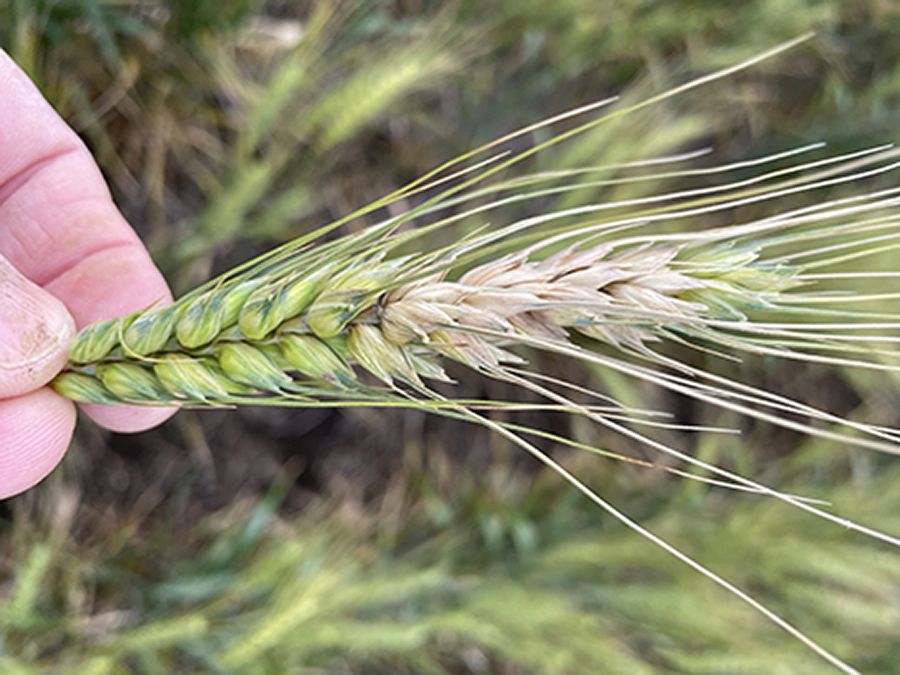
Fusarium head blight in wheat. Photo: Rob Holmes
However, the recent flooding will make this difficult, and we also have significant areas of riparian land and grazing land that can sustain the green bridge for rusts.
In 2023, varieties with high levels of resistance to crown rot and stripe rust would be the most desirable. We expect those to be the two big diseases of next year, with crown rot looking to be the biggest concern, especially if we return to drier and warmer conditions during grain filling.
With stripe rust we will be looking for moderately resistant (MR) or moderately resistant (MR) to moderately susceptible (MS) varieties and avoiding moderately susceptible (MS) and susceptible (S) varieties.
The University of Sydney’s Australian Cereal Rust Survey is a good reference for showing the pathotypes that can exist within a season and help us more accurately choose suitable varieties. We have submitted many samples for pathotype testing from our area in 2022 so we should have a good handle on risk for 2023.
Emma Robinson, southern NSW
 At Temora, in the south-west slopes region of NSW, Nutrien Ag Solutions agronomist Emma Robinson provides advice to mixed farmers growing winter crops.
At Temora, in the south-west slopes region of NSW, Nutrien Ag Solutions agronomist Emma Robinson provides advice to mixed farmers growing winter crops.
This season was a mixed bag with stripe rust, Septoria and powdery mildew impacting wheat crops to a varying extent across the district.
In the lead-up to harvest, many cereal crops around Temora looked clean for stripe rust with minimal flag leaf scarring or new rust activity. Head infection levels were low despite some clients reporting poor foliar fungicide timing.
This can largely be explained by a proactive approach to disease management and crops that received flutriafol (Impact in-furrow) applied to starter fertiliser were the standouts. They remained relatively free of stripe rust well past growth stage 34 to 35 in most cases, until planes, helicopters or three-point linkage tracked sprayers could be organised. This certainly eased the pressure on in-crop management.
Some moderately susceptible (MS) varieties only had a growth stage 37 spray and no flag leaf spray due to wet conditions. Despite this, the crops were midway through grain fill by the end of October with very low levels of stripe rust on the flag leaf.
However, some growers took a reactive approach and did not apply flutriafol at sowing. In these cases, if in-crop foliar fungicide application was delayed by rain or paddock trafficability issues until after the disease appeared, crops are now very dirty for stripe rust on the flag leaves and in the head. For these growers, yield penalties could be significant, but the wet mild finish will aid grain fill.
Septoria a concern
This year, Septoria tritici blotch (STB) caused the highest damage to the flag leaf and potential yield loss of all foliar diseases.
Typically, we would manage for STB with a timely application of fungicide at GS31 for all varieties. The first spray is mandatory. If it is wet, another foliar fungicide application is required at GS39, which will also protect against stripe rust.
However, this year, even crops sprayed on time and twice have high levels of STB on the main ‘money leaf’ (flag leaf).
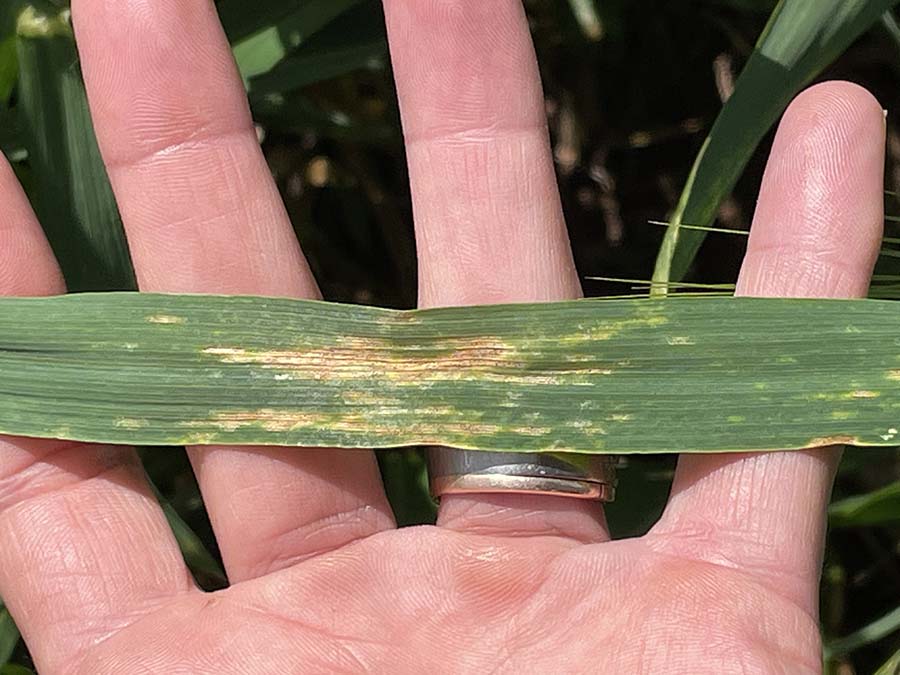
Septoria on wheat. Photo: Emma Robinson
In those crops where rain or paddock trafficability meant fungicide application was later than desired, we saw STB take out at least half of the flag leaf.
Susceptible varieties
For stripe rust, the varieties with the most infection were Vixen, Boree, RockStar, Scepter, Catapult and Coota, which was not surprising given their resistance ratings.
For STB, the varieties most affected were Illabo, Beckom, Scepter and LongReach Trojan. These are all susceptible (S) to moderately susceptible (MS) to STB, so their levels of infection were not surprising.
Powdery mildew was observed. Scepter and Beckom were the worst affected in an isolated north-eastern area of Temora. This is not surprising because both varieties have low levels of wheat powdery mildew resistance.
With susceptibility to stripe rust, STB and wheat powdery mildew, Scepter has three strikes against it. Beckom has two strikes against it with susceptibility to STB and wheat powdery mildew.
The year ahead
Variety selection will be the backbone of disease planning for 2023. Most growers have LongReach Lancer, Illabo, LongReach Kittyhawk or Beckom in their variety stable. For those who do not, we will plan to have a percentage of these varieties to reduce the pressure from stripe rust.
If we have a normal winter in 2023 and wet spring conditions, all these varieties – besides LongReach Kittyhawk – will require STB and wheat powdery mildew management with fungicides.
The green bridge for disease is routinely managed well around Temora because we knock down weeds all summer to conserve moisture and nitrogen, which are our key yield drivers for the coming season.
For the past 15 years, many growers around Temora have been using flutriafol on their starter fertiliser. Based on the evidence again this year, this will be a strong recommendation for the coming season because it is the best investment for early proactive rust management and root disease.
In 2023, we will plan to spray nearly every variety twice with foliar fungicides due to the high inoculum levels of both STB and stripe rust in the area.
Unfortunately, besides LongReach Kittyhawk, no single variety is resistant to both stripe rust and STB.
However, growing varieties such as LongReach Lancer, Illabo, LongReach Raider, LongReach Stealth, LongReach Kittyhawk and Beckom will help reduce the risk of stripe rust within the region.
Each year, we aim to rotate fungicides and modes of action. Next year will be no exception.
We find the University of Sydney’s Australian Cereal Rust Survey interesting. It is useful to know the locations of the different rust pathotypes. For example, the results showed that two pathotypes were on the same variety sampled from the same paddocks in 2022. The university’s role in discovering new rust pathogen mutations is important to help us understand how different wheat varieties react, the changing rust reactions of our cultivars and breeding selection.
John Stuchbery, Victoria
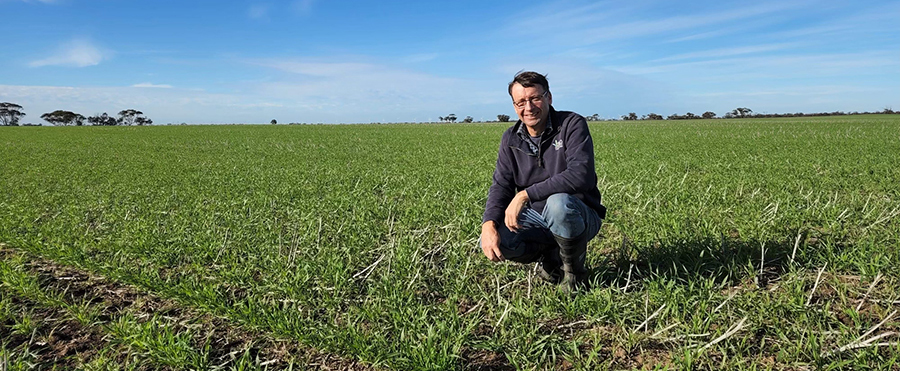
John Stuchbery is an independent agronomist based at Donald, Victoria. He advises growers cultivating winter crops in the Wimmera’s medium-rainfall zone.
We saw stripe rust head infection in most crops. The worst affected were those with higher leaf infection levels before ear emergence.
Many crops were sprayed with a third fungicide at ear emergence, which helped to reduce head infection and provided additional protection for the flag leaves during the cool, wet seasonal finish.
There was plenty of Septoria tritici blotch (STB) present, but a proactive fungicide program provided a good level of control.
Wheat powdery mildew appeared late in the season on lower leaves and stems, with a few cases of ear infection.
It was generally suppressed well with fungicide application, resulting in very little damage, but it is a potential issue for 2023.
Until this season, there has been very little powdery mildew in the Wimmera and Mallee.
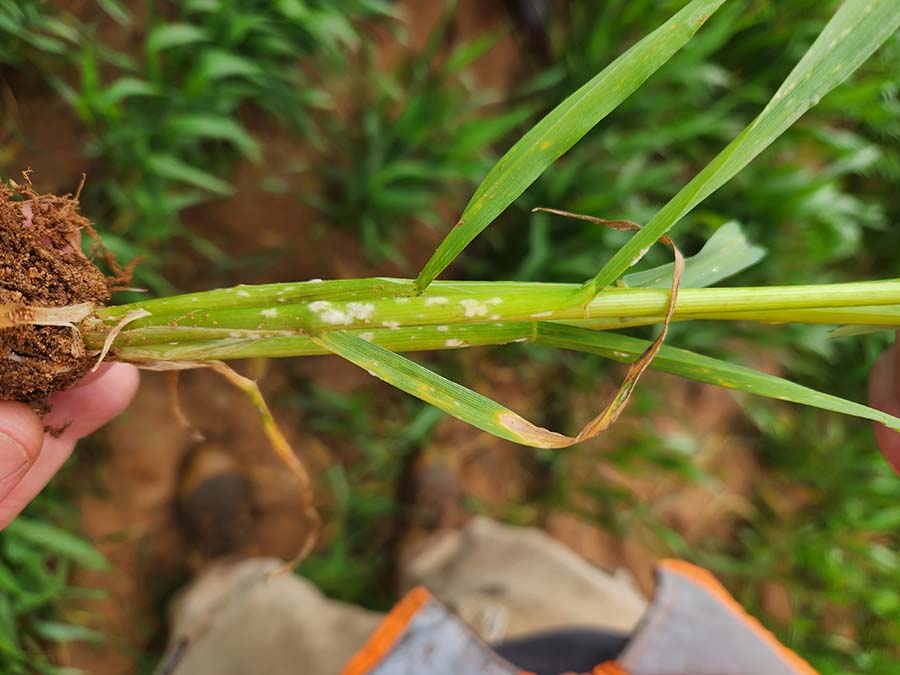
Powdery mildew on wheat. Photo: John Stuchbery
Vixen, RockStar and Sheriff CL Plus were the varieties worst affected by stripe rust, but Scepter and Calibre also had plenty of infection. Beckom had noticeably less stripe rust but more STB.
Most of the powdery mildew was in Scepter, the dominant variety around the area. The amount of disease and the rate at which it developed in crops lined up with the resistance ratings of varieties.
Yield loss to stripe rust was minimal where fungicides were applied on time. Any delays to application resulted in noticeably more disease and more yield loss. I would estimate about 10 to 15 per cent overall, but some crops have lost significantly more than that from stripe rust in 2022.
Proactive approach
We knew about the disease risks early, so we advised clients to apply fungicide proactively. This worked well where the application timing was right, but the disease proliferated where fungicide application was delayed.
Trafficking wet paddocks and achieving the right spraying conditions has been a problem this season.
Green bridge
When it comes to managing the green bridge over summer, summer weed control is a critical part of the farming system in the medium and low-rainfall zones. Controlling volunteers is standard practice.
Variety selection
With a wet forecast going into 2023, we suggest avoiding varieties that are susceptible and very susceptible to stripe rust.
Finding alternatives to susceptible and very susceptible varieties for wheat powdery mildew is more difficult, however, as there are fewer options. This is potentially a bigger threat moving forward, given the difficulties experienced with control in other regions.
Fungicide program
In the past, applying flutriafol to winter cereal fertilisers did not reduce the number of fungicide passes needed, but it did allow more flexibility with the timing of the first foliar fungicide application by keeping disease levels low in the early stages of a stripe rust epidemic.
The advice to apply flutriafol to winter cereal fertilisers is based on logistical considerations, such as the grower’s capacity to apply foliar fungicides at critical times. This may change in future, however, with the increasing prevalence of wheat powdery mildew.
For 2023, we recommend varieties with higher resistance ratings where possible, but due to the limited choice, fungicides will play a crucial role as well in leaf disease management.
The University of Sydney Cereal Rust Survey has been useful for understanding pathotype spread and providing early warnings on changes to resistance ratings.
Jeff Braun, South Australia
 Independent agronomist Jeff Braun with son Zac. Jeff advises growers on South Australia’s Yorke Peninsula, the mid-north and Mallee.
Independent agronomist Jeff Braun with son Zac. Jeff advises growers on South Australia’s Yorke Peninsula, the mid-north and Mallee.
We saw a lot of later tillers with head infections of stripe rust and wheat powdery mildew as these heads had not yet emerged at the time of foliar fungicide application.
In many areas, we applied a flag leaf top-up spray (GS55-61) with pleasing results. The third fungicide made a huge difference for green leaf duration and reducing stripe rust head infections.
We saw plenty of stripe rust in RockStar and Sheriff CL Plus, Vixen, DS Bennett and Catapult.
Scepter’s reaction to stripe rust has been variable. In some cases, it has appeared more susceptible than its rating would suggest which might indicate the presence of multiple pathotypes in the region.
Ballista in the Mallee has been doing well against stripe rust. Calibre has also been holding up well this year, although it appears that it may not be as strong against Septoria tritici blotch (STB).
Quite late in the crops’ development, we had STB infections increase in some late-sown districts. In most situations, we decided to go with tebuconazole for the third spray, and it did not control STB very well. This could be associated with reduced fungicide sensitivity within the pathogen.
Unfortunately, we are limited for options in those areas because there is a frost risk still in many of these districts, so we are concerned about the fungicide maximum residue limit if the crop ends up being cut for hay.
Diseases controlled
We have not seen many paddocks where stripe rust has caused significant yield loss. The odd paddock that had a fungicide delayed by two to three weeks past the optimum flag leaf stage (GS39), I estimate, may have lost about 20 per cent of yield due to a lack of green leaf area and resulting grain size issues.
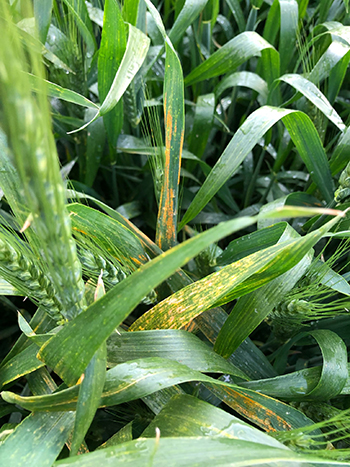 Stripe rust on RockStar (PBR) wheat. Photo: Jeff Braun
Stripe rust on RockStar (PBR) wheat. Photo: Jeff Braun
Overall, I am very happy with the disease control growers achieved this season. The main thing I would have changed, if I could, would be to have flutriafol on all fertiliser applied at seeding, which would have made a huge difference.
Nonetheless, looking ahead to 2023, I will not be giving a blanket recommendation to use flutriafol. Its use depends on the environment.
More importantly, having enough foliar fungicides for a third application was highly valuable this year. With this in mind, it may be beneficial to have some extra product in the shed in preparation for next season.
The other big lesson this year was recognising when a fungicide could not be applied on time and seeking help to make it happen.
Most growers also have pulses in their farming systems, which adds considerably to their spraying programs.
Accordingly, many growers hired contractors or an aeroplane to apply fungicides, allowing applications to remain timely. This a lesson we will want to carry forward in 2023.
Coming into summer, most growers control the green bridge very well. The primary purpose is moisture retention but breaking the disease cycle is always a bonus.
Yield is king
The varieties we will be recommending for 2023 will be primarily based on what achieves the highest yield and what best tolerates sprouting or shattering.
In most cases, I am comfortable recommending more-susceptible varieties with higher yield potential because we can keep the disease under control using fungicides.
There may be some situations where growers have very large programs or historically have issues trafficking crops due to moisture for timely sprays, where we may recommend a variety with higher levels of resistance.
Trent Butcher, Western Australia
 ConsultAg research agronomist Trent Butcher is based in Narrogin, Western Australia. He advises mixed farmers and continuous croppers from the west of Narrogin to Lake King in WA’s eastern grain belt.
ConsultAg research agronomist Trent Butcher is based in Narrogin, Western Australia. He advises mixed farmers and continuous croppers from the west of Narrogin to Lake King in WA’s eastern grain belt.
Stripe rust has not been an issue in Western Australia as we do not have the range of pathotypes circulating in eastern Australia. We have had a little powdery mildew in the wheat heads of crops that were not sprayed with fungicide.
Septoria was only a minor problem. There was about a month of dry weather in October, which reduced infection further.
The crops that showed bad infection early were treated with fungicide, but the crops that only had marginal infection were left untreated, and they did not need a fungicide spray given the dry spring.
Scepter wheat was the variety most vulnerable to wheat powdery mildew. Septoria was an issue in Bannister oats until the dry spell. Spartacus CL barley was susceptible to spot form net blotch.
Scald in barley will be another disease to keep an eye on in 2023, as it was surprisingly prevalent this year, even in varieties that are meant to have decent levels of resistance.
With the shift away from RGT Planet to other barley varieties, scald susceptibility may be of higher concern. Active monitoring will likely be the solution in the short term. Other growers may opt for effective seed treatment as a precaution.
Overall, there is not much we would have changed about our disease management approach this year.
Powdery mildew was at high-pressure than we expected, but it appeared quite late. At the moment, powdery mildew is about a one-in-five-year event. With our knowledge going into this year, we would not have changed much in how we prepared for it.
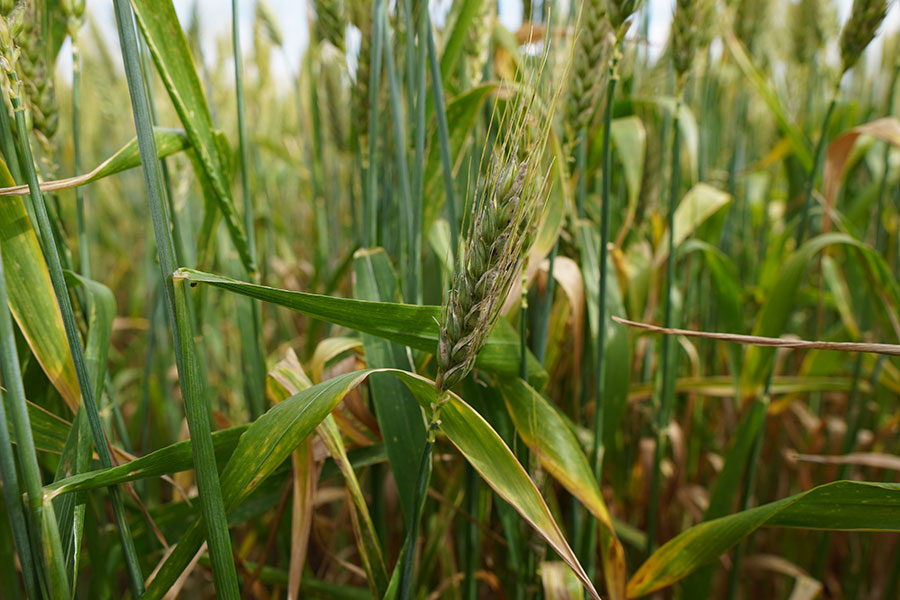
Powdery mildew was found at higher levels than expected in Western Australia. Photo: Trent Butcher
Over the summer, our policy on the green bridge will not change; we do not want any self-sown wheat or grass weeds to survive.
Moisture conservation is the main goal, and if we reduce pathogen survival in the process, that is an extra benefit. We will be vigilant.
While we are always looking for varieties with more broad-spectrum disease resistance, yield will be our biggest priority when choosing varieties for 2023.
However, the green bridge may influence variety selection decisions if wet conditions make it a high-disease-pressure summer for survival of pathogens such as the rusts.
Mostly, using flutriafol on starter fertiliser is about the grower’s attitude to risk and how effectively they can traffic an area with fungicide later in the crop’s development.
The use of flutriafol is usually recommended on what the grower has done historically, but if it is a wet summer, some more people may decide to apply flutriafol.
Variety resistance
Variety resistance would make a big difference with wheat powdery mildew but, currently, there is not widespread availability of varieties with resistance to this disease.
Accordingly, we will work with what we have, but if it proves to be a big issue again next year, we may need to start transitioning to varieties with better wheat powdery mildew resistance.
When choosing varieties and considering their level of resistance for 2023, it will be important to consider the disease pressure of the environment you are planting in and plan fungicide applications according to the susceptibility of the variety.
Regarding spot form net blotch, we are already on the path to growing barley varieties with better resistance, with Maximus CL and Commodus CL.
Where net form net blotch is an issue in RGT Planet, we may be looking at swapping that out in future as well.

























































